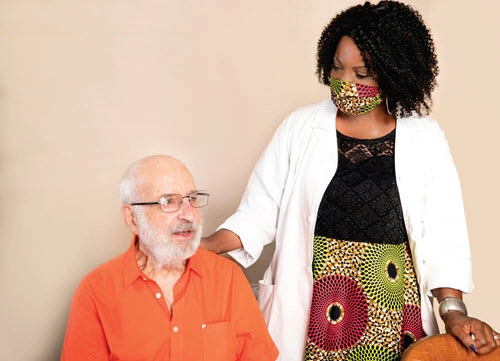MDS Alert
Bolster This One Aspect of Administrative Efforts to Boost Safety
Community transmission rates alone don’t explain the outbreak numbers. Across the entire country, only 64 out of roughly 13,380 nursing homes have not experienced a case of COVID-19, and most nursing homes experienced multiple outbreaks and weeks of sustained transmission, according to a May 2021 report by the Government Accountability Office (GAO). While studies have shown that rates of community transmission, outside of the facility, have a tremendous impact on COVID-19 infection rates in nursing homes, resident safety generally seems to be achieved by adequate staffing of competent professionals. Focus on Staffing to Solve Many Problems Staffing is an evergreen issue for the long-term care industry, and insufficient staffing, in terms of numbers as well as competency, had a big effect on COVID-19 management. “These officials frequently highlighted the risks posed by a failure or inability of a nursing home to implement robust infection control practices to control the spread of the virus. For example, officials noted that once COVID-19 enters a home— which can be more likely when community transmission is high—the ability of the home to quickly test, identify, and separate infected residents and staff before they infect others is critically important to stopping the spread,” says John E. Dicken, director of the health care division of the Government Accountability Office (GAO). These efforts are obviously all tied to staff — did they have enough training to identify symptoms of COVID-19, the authority to make decisions on resident isolation and resources to isolate residents, the pay to justify coming into extremely dangerous conditions day in and day out? Do they now? “The long term care industry faced widespread staffing challenges long before the pandemic began. For years we have called on federal and state governments to implement policies that will help us recruit and retain more staff to our field. The pandemic has exacerbated these shortages, and employment in long term care is on a startling decline. The latest labor report shows that the health care sector lost about 19,500 nursing home and residential care jobs,” says Mark Parkinson, president and CEO of AHCA/NCAL. Prioritize Infection Prevention and Control Infection prevention and control has been a weak spot for many facilities, even before the pandemic, the GAO reports, but again, a lot of those issues stem from larger problems related to staffing numbers and training. GAO data analysis shows that 82 percent of all surveyed nursing homes had at least one deficiency related to infection prevention and control from 2013-2017. Approximately 40 percent of surveyed nursing homes were cited with a deficiency related to infection prevention and control in 2018 and 2019. These deficiencies included surveyor citations for situations ranging from observing staff not performing proper or adequate hand hygiene to failure to isolate sick residents or use personal protective equipment (PPE), but virtually none of the violations were considered “severe,” nor did the facilities face enforcement action. However, staff were often the cause of an outbreak — an unsurprising fact, given that staff have lives beyond working at facilities — but resources like PPE, which was especially hard to come by for much of the long-term care industry in much of the pandemic, limited the ways in which staff could protect themselves, residents, and each other. “For both long- and short-duration outbreaks, over half of the nursing homes (66 percent or 8,720 nursing homes) reported that these outbreaks began with a staff case the first week of the outbreak,” Dicken says. But again, staffing — enough people with sufficient training — is probably at the root of this problem. “… [I]t can be difficult for nursing homes to adhere to infection control practices without adequate staffing. Staffing shortages can occur if staff are out due to illness, and frequent staff turnover makes it difficult for the home to ensure that new staff are trained on proper infection control practices,” Dicken says. Facilities with more beds, more residents, and more staff tended to have a higher incidence of infection, which makes sense, since they also have higher risk of exposure and more people to manage. “… [L]arger homes will inherently incur a higher risk of having at least one case, given that they have more residents and staff, each of whom could become that case. In addition, studies have shown that larger nursing homes with more beds and, subsequently, more residents and staff, may have a higher risk of exposure to COVID-19—particularly in areas of high community spread—and thus greater potential for more people in the facility to become infected,” Dicken says. Larger homes may have more staff moving back and forth between units or wings or buildings, leading to more infections, especially when PPE was hard to come by. Do What it Takes to Keep Staff Safe and Happy Long-term care professionals have had an exceptionally difficult year, showing up for physically and emotionally draining work in dangerous conditions, without much acknowledgement of just how hard it was. “From day one of the COVID-19 pandemic, heroic caregivers in our long term care facilities have stood on the front lines to protect our most vulnerable. Despite being forgotten at the outset, they worked day and night to protect our nation’s seniors and individuals with disabilities from this deadly disease. Their bravery and refusal to give up helped save lives,” Parkinson says. The industry at large probably has not yet reconciled how to move forward in a way that provides an emotionally, mentally, financially, or physically sustainable environment for staff, while also providing high-quality, patient-centered care. Leaders in the industry are looking to Congress to make legislative changes that would help on both fronts. “There will be an increased demand for long term care services, and without more staff, we will be unable to meet that demand. It’s time for lawmakers to help us address this crisis. We and LeadingAge have proposed the Care for Our Seniors Act, which offers several solutions that will help us strengthen our workforce, and we support the reintroduction of the 2019 Ensuring Seniors Access to Quality Care Act (S. 2993) to help retrain certified nursing assistants (CNAs). We are eager to work with lawmakers on these reforms that will create more meaningful jobs and ensure that America’s seniors receive the best care possible,” Parkinson says. Really putting genuine, meaningful focus on how to keep staff happy and engaged may be a surprisingly impactful way to curb the lasting effects of the pandemic.

MDS Alert
- Surveys and Compliance:
Make These Adjustments for COVID-19 Vaccinations Now
The first reporting period is just around the corner in mid-June. On May 11, 2021, [...] - COVID-19:
Bolster This One Aspect of Administrative Efforts to Boost Safety
Community transmission rates alone don’t explain the outbreak numbers. Across the entire country, only 64 [...] - Quiz:
Test Your Knowledge about SCSAs
Being familiar with the nuts and bolts of hospice situations may help! Knowing when to [...] - Quiz Answers:
Pocket These SCSA Facts
Make your SCSA coding easier by confronting the nitty-gritty. Check your answers against these, along [...] - Reader Questions:
Don’t Neglect Cybersecurity
Question: What should our organization be doing right now to make sure we’re not the [...] - Reader Questions:
Remember This Timing for Hospital Observations
Question: If a resident goes to a hospital emergency room and receives intravenous (IV) medication [...] - Reader Questions:
Avoid Unnecessary Work in This Discharge Situation
Question: A colleague completed a prior OBRA Discharge assessment for a resident, noting that the [...]

